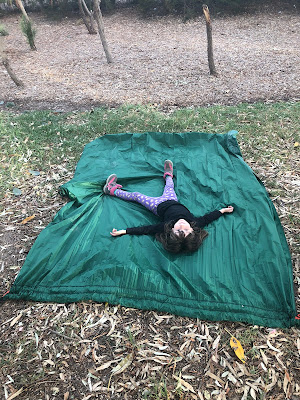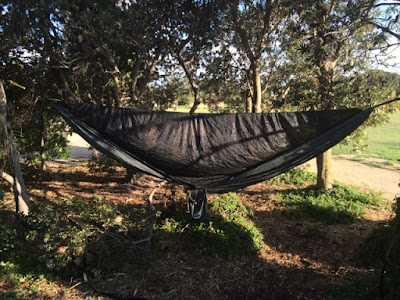A well made tarp is a crucial bit of kit that every outdoors expedition could benefit from, be it rain or wind shelter, shade or just a dry and prickle free place o picnic upon. Though at times a 9 x 12 tarp may be a bit too much, especially if you're just planning for a bit of a trail hike. Then there is your gear, be it packs, cook gear, bedding or even boots at the end of a long day. If like me you prefer a slung hammock to a ground tent there is the question of what to do with your gear, if whatever fly system you have doesn't cover it. The clever people at GO! Outfitters came up with something to fit that niche, the Landing Pad.
It’s made from durable 70D polyester, with a 1000mm waterproof polyurethane coating on the bottom and a silicone coating on the top for extra protection and easy clean up. This makes the Landing Pad extremely waterproof.

The Landing Pad is 137cm (54") in diameter and has eight stake loops and four sets of drawstrings with cord locks around its outer edge. It comes with a set of steel hook-style tent stakes in a draw string bag to stake it down as needed. At 137cm in diameter, the circle is big enough that 4 people could sit on it back to back or three facing inwards, if legs can be managed. Certainly big enough for a trail-side picnic or to drop bags and boots on whilst hopping into your hammock. Stake it down under your hammock for a soft place to step onto once you swing your legs over but before you put your boots on.

The four drawstrings around the edge of the Landing Pad allow for the lips to be drawn up into a low bathtub to keep damp ground run-off out. It also allows for the whole circle be drawn up like a purse to wrap your gear in a highly water proof bag. Obviously the opening isn't covered, so don't be throwing it in a pool or leaving it under a waterfall. By pulling two opposing drawstrings the landing Pad converts into a gear hammock, stretching 2.4m (7'10") overall with a 1m (3') hammock space. Though it can be drawn tighter doing so reduces the capacity. I would use it as an along-side sling, rather than bunk-style to keep things in reaching distance and act as a buffer.
 This drawstring rim also enables the Landing Pad to be fitted over a backpack to shelter it from the weather and could supplement a poncho to keep both you AND your gear dry. I found it big enough to be able to wear it like a turtle-back poncho, covering my back, butt arms and back. Its even big enough that I could shelter under it like an umbrella when couched, staying totally covered.
This drawstring rim also enables the Landing Pad to be fitted over a backpack to shelter it from the weather and could supplement a poncho to keep both you AND your gear dry. I found it big enough to be able to wear it like a turtle-back poncho, covering my back, butt arms and back. Its even big enough that I could shelter under it like an umbrella when couched, staying totally covered. I found that the tan/brown material made for quite the unobtrusive "hide" when crouched down under it when just off-trail. It occurs to me that with an expanded hiking stick or appropriately padded branch you could make a small single pole shelter with the Landing Pad, properly staked out.The Landing Pad, with stakes and stuff-sack weighs 285g (10oz) and by itself 15g (5.3oz) and packs down to a pocket sized 4cm X 13cm X 18cm (1.5" X 5" X 7").

















































